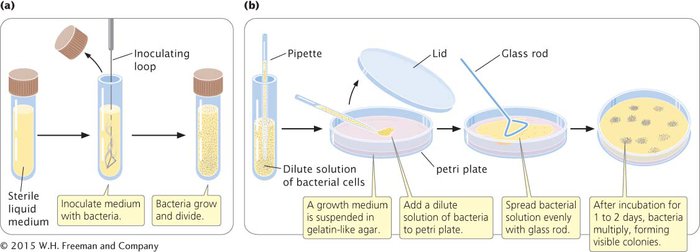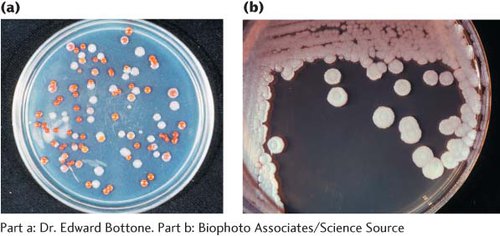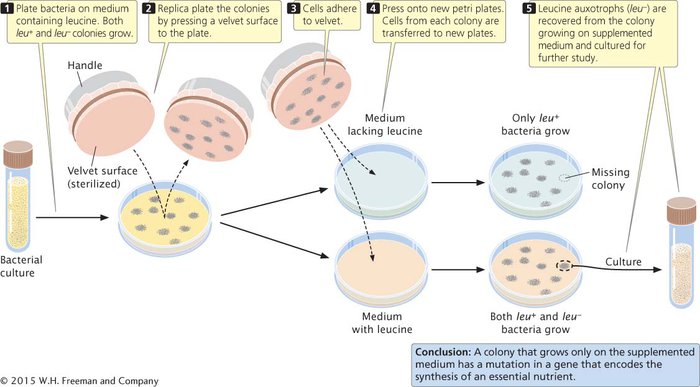Techniques for Studying Bacteria
The culture and study of bacteria require special techniques. Microbiologists have defined the nutritional needs of a number of bacteria and developed culture media for growing them in the laboratory. These culture media typically contain a carbon source, essential elements such as nitrogen and phosphorus, certain vitamins, and other required ions and nutrients. Wild-type (prototrophic) bacteria can use these simple ingredients to synthesize all the compounds that they need for growth and reproduction. A medium that contains only the nutrients required by prototrophic bacteria is termed minimal medium. Mutant strains called auxotrophs lack one or more enzymes necessary for synthesizing essential molecules and will grow only on medium supplemented with those essential molecules. For example, auxotrophic strains that are unable to synthesize the amino acid leucine will not grow on minimal medium but will grow on medium to which leucine has been added. Complete medium contains all the substances, such as the amino acid leucine, required by bacteria for growth and reproduction.

Figure 7.1: Bacteria can be grown (a) in liquid medium or (b) on solid medium.
Cultures of bacteria are often grown in test tubes that contain sterile liquid medium, or “broth” (Figure 7.1a). A few bacteria are added to a broth tube, and they grow and divide until all the nutrients are used up or—more commonly—until the concentration of their waste products becomes toxic. Bacteria may also be grown on agar plates (Figure 7.1b), in which melted agar is suspended in growth medium and poured into the bottom half of a petri plate. The agar solidifies when cooled and provides a solid, gel-like base for bacterial growth. In a process called plating, a dilute solution of bacteria is spread over the surface of an agar plate. As each bacterium grows and divides, it gives rise to a visible clump of genetically identical cells (a colony). Genetically pure strains of the bacteria can be isolated by collecting bacteria from a single colony and transferring them to a new broth tube or agar plate. The chief advantage of this method is that it allows one to isolate and count bacteria, which individually are too small to see without a microscope.
Microbiologists often study phenotypes that affect the appearance of the colony (Figure 7.2) or that can be detected by simple chemical tests. Auxotrophs are commonly studied phenotypes. Suppose that we want to detect auxotrophs that cannot synthesize leucine (leu− mutants). We first spread the bacteria on a petri plate containing medium that includes leucine; both prototrophs that have the leu+ allele and auxotrophs that have the leu− allele will grow on it (Figure 7.3). Next, by using a technique called replica plating, we transfer a few cells from each of the colonies on the original plate to two new replica plates: one plate contains medium to which leucine has been added; the other plate contains a medium lacking leucine. A medium that lacks an essential nutrient, such as the medium lacking leucine, is called a selective medium. The leu+ bacteria will grow on both media, but the leu− mutants will grow only on the medium supplemented with leucine because they cannot synthesize their own leucine. Any colony that grows on medium that contains leucine, but not on medium that lacks leucine, consists of leu− bacteria. The auxotrophs that grow only on the supplemented medium can then be cultured for further study.

Figure 7.2: Bacteria have a variety of phenotypes. (a) Serratia marcescens with color variation. (b) Bacillus cereus.
[Part a: Dr. Edward Bottone. Part b: Biophoto Associates/Science Source.]

Figure 7.3: Mutant bacterial strains can be isolated on the basis of their nutritional requirements.


